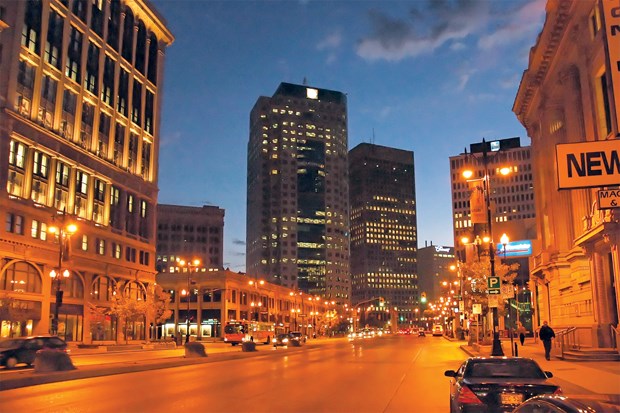WINNIPEG: Back in the 1880s, when Winnipeg was the fastest growing place in North America, immigrants from Europe came by ship to Halifax then train to this frontier city put on the map by fur trappers and traders at the junction of the Red and Assiniboine rivers.
At Union Station, beside rail yards bigger than anything at Chicago or New York, the immigrant trains made their first stop and weary travelers were allowed to disembark, other than
Italians and Spaniards, who in a process not unlike Ellis Island, were deemed too emotional (in the words of a local historian) for the hard life on the Prairies, and shunted back to Toronto.
Beyond the frontier was the Canadian West including the faraway Vancouver, then very much the village on the edge of the rainforest. It took Vancouver three generations after the arrival of the first trans-continental rail train, in 1886, to catch up with Winnipeg, but until then the head office of the Canadian West was Winnipeg's skyscrapers at Portage and Main.
In this golden era, the Siftons, Eatons, Aspers and Richardsons would build mansions on Wellington Crescent, and one of their ilk would perish on the Titanic, in first class of course. Only the building of the Panama Canal put the brakes on Winnipeg's astonishing growth.
Since then Winnipeg has averaged a steady prosperity with a rising real estate market today, but one that does not cast its children into the wilderness.
It has a new football stadium, the hockey team is back, and going up is a 28-floor tower at Portage and Main. And the trains are still running, such as Via Rail's Canadian, which I took from Winnipeg to Vancouver. I could have gone the way from Toronto, but I wanted to see the land that drew fellow Scots to the Red River settlement.
They came first to the railway station at the Forks, as the meeting place of the great rivers is known, which has seen the Hudson's Bay Company, the Northwest Company, Louis Riel, the Grey Nuns, Ukrainians and Icelanders.
Lower Fort Garry, a former Hudson's Bay post and now a superb visitor centre run by Parks Canada, had been my primary goal, but Icelanders? So I drove to Gimli and on to Hecla Island, where Lakeview Resorts has attractive and affordable hotels. Hecla, which Icelanders settled in 1875, has a story to rival the Red River settlement, of resolute people carving a home in harsh conditions and becoming an admirable part of the Canadian story.
It's an easy drive from Winnipeg, for the beach at Gimli, good golf at Hecla and don't miss the pickerel (walleye) fish. The old runway, famous for the Gimli Glider of 1983 when Air Canada dropped in, now sees lots of amateur pilots flying in for the fishing.
Back in Winnipeg, and prior to boarding my train, the Canadian, I joined a city tour for passengers en route from Toronto, the highlight of which was Assiniboine Park and Leo Mol's statues. If you never go anywhere else in Canada, don't miss Winnipeg and this man's breathtaking bronze of bush pilot Tom Lamb.
Spare time too to find a wonderful statue of First World War soldier Lt. Harry Colebourn and a little bear he rescued en route to the U.K. and called Winnie after his home town. When Colebourn, a vet with the Fort Garry Horse, was sent to France, Winnie was placed in London Zoo where he enchanted Christopher Robin and A.A. Milne, and was the inspiration for Winnie the Pooh. Colebourn survived the war, returned to Winnipeg, and died in 1947.
As for the train, every real Canadian should do this, for its building is another key part of the Canadian fabric, something clearly not lost on the broad ethnic makeup of the passengers, many foreign tourists, a honeymoon couple and the very well behaved Scouts on their way from Peterborough to a jamboree in Edmonton.
Jasper was a good stop with an hour in the town centre, although for many the priority was the free Wi-Fi Via Rail provides in stations. Hotels please note.
Then the best bit.
We skirted Moose Lake, headwater of the mighty Fraser River, glimmering in the afternoon sun, and headed to Yellowhead Pass, the continental divide. The scenery was spectacular on one side, then the other. The panorama car echoed with gasps of wonder at soaring, snow-capped mountains and the rushing Fraser. "This is the trip of a lifetime," said a man in a Tilley hat. Even the honeymoon couple, till now just eyes for each other, were visibly impressed.
"Mount Robson, highest point in the Rockies, on the right," said the conductor, whose comments were sparing but spot on, such as sports commentators should be but rarely are.
And so we followed the mighty Fraser all the way to Vancouver with dreamy sunset views, very good food and service, comfy beds --and no airport security. Can't think why I never did it before.
For more info: viarail.ca.



